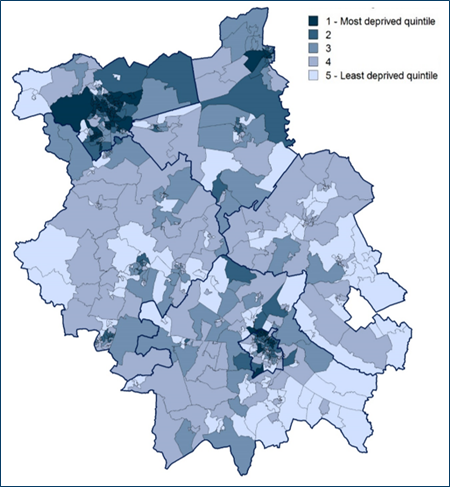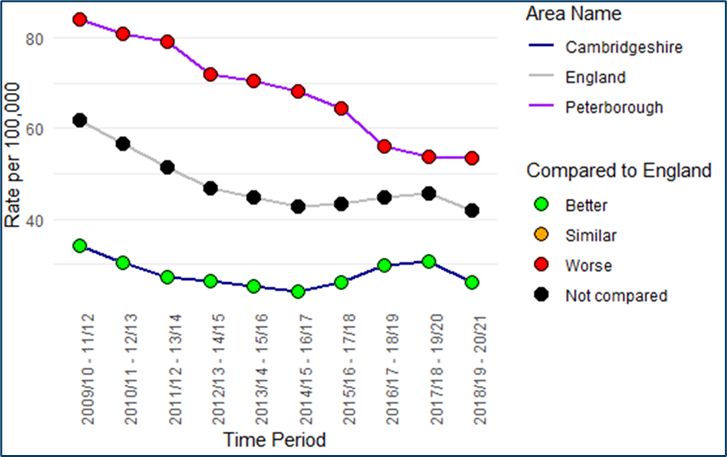Crime, Safety and Violence
There is a complex relationship between crime and mental health, both in terms of victims of crime and offenders.
Why is crime, safety and violence important to mental health?
- High neighbourhood crime rates are associated with psychological distress and depression (104).
- Higher levels of perceived neighbourhood safety are linked to good wellbeing (105).
Victims of crime
- Being a victim of violent crime is a risk factor for mental illness, particularly post-traumatic stress disorder (PTSD) and depression (106).
- Compared to the general population, people with mental health problems are:
- 3 times more likely to be a victim of crime (4).
- 5 times more likely to be a victim of assault, rising to 10 times more likely for women (4).
- More likely to report negative experiences when reporting crimes, including police being unfair and disrespectful (107).
- Being a victim of intimate partner violence or domestic abuse increases the risk of mental health problems. There are high rates of mental health conditions, particularly PTSD, among people who have been raped (4).
- Living in a family with inter-parental violence in childhood is a strong predictor of adult mental illness (108).
- Sexual violence is a strong risk factor for poor mental health: it has been estimated that if young people were not subject to sexual violence, the prevalence of serious mental health outcomes in 17-year-olds would be 4 to 11% lower in young men and 14 to 19% lower in young women (109).
- Older adults who experience abuse are more likely to experience depression and anxiety, and 5 times more likely to attempt suicide (134).
Offenders
- There are high rates of mental health and learning disability need in the prison population: 71% of women and 47% of men in prison report having mental health problems (110).
- These disorders are often more severe and complex than those in the general population and can be combined with poor physical health and substance misuse (4).
Rates of mental health conditions in offenders, and the barriers this group face when accessing mental health support, will be discussed in more detail in the next chapter of this report.
What is the national picture?
- Cuts to legal services have had significant impacts on the mental health of victims of crime and their families, leading to people feeling ‘stressed, powerless and unable to get on with life’ (111).
- There is an increasing backlog of court cases, which has grown over the pandemic (112).
What is the local picture?
- There are areas of high rates in crime deprivation C & P (16).
- This measure combines rates of violent crime, burglary, theft and criminal damage, with high levels of deprivation indicating high levels of crime.

Figure 30: Crime deprivation across C & P. Data source: (16)
- The overall crime rate in C & P is similar to regional and national trends over time (113). However, the violent crime rate in Peterborough is significantly higher than the national average (44).
Offenders
- The proportion of offenders who go on to reoffend is higher than the national average (27.9%) in Cambridge (33.7%) and Peterborough (30.5%) (44).
- The rate of 10 to 17-year-olds receiving their first reprimand, warning, or conviction per 100,000 population is higher than the national rate in Peterborough, and lower than the national average in Cambridgeshire. However, an overall decline has been seen in Cambridgeshire and Peterborough since 2010 (44).

Figure 31: First time entrants to the youth justice system, rate per 100,000. Data source: (44)
Victims of crime
- There was a peak in referrals to the local Independent Domestic Violence Advisor service in the first quarter of 2021/22, though rates have since reduced (114). This service supports medium-high risk victims of domestic abuse.
- There were 270 referrals to this service in Cambridgeshire and 161 referrals in Peterborough in 2021/22 (114).
- The number of admissions to hospital resulting from violent crimes has fallen since 2010.

Figure 32: Hospital admissions resulting from violent crimes in C & P. Data source:(44)
- Rates of sexual offences are increasing in all local districts except East and South Cambridgeshire (44). Rates of sexual offences in Peterborough are higher than both levels in all Cambridgeshire districts and the English average (44).
Additional resources
- The local data pack gives an overview of key data and trends
- The most recent needs assessment in this area: Cambridgeshire & Peterborough Needs Assessment: Victims, Suspects and Offenders: 2019/2020
- NIHR summary of the importance of community safety and the criminal justice system to public mental health
- Further local data on crime and community safety
References
Full list of references can be found here
- Baranyi G, di Marco MH, Russ TC, Dibben C, Pearce J. The impact of neighbourhood crime on mental health: A systematic review and meta-analysis. Vol. 282, Social Science and Medicine. 2021.
- Choi YJ, Matz-Costa C. Perceived Neighborhood Safety, Social Cohesion, and Psychological Health of Older Adults. Gerontologist. 2018;58(1).
- Kilpatrick DG, Acierno R. Mental health needs of crime victims: Epidemiology and outcomes. In: Journal of Traumatic Stress. 2003.
- Pettitt B, Greenhead S, Drennan V, Hart T, Hogg J, Borschmann R, et al. At risk, yet dismissed [Internet]. 2013 [cited 2022 Oct 6]. Available from: https://www.mind.org.uk/media-a/4121/at-risk-yet-dismissed-report.pdf
- Fryers T, Brugha T. Childhood Determinants of Adult Psychiatric Disorder. Clinical Practice & Epidemiology in Mental Health. 2013;9(1).
- Bentivegna F, Patalay P. The impact of sexual violence in mid-adolescence on mental health: a UK population-based longitudinal study. Lancet Psychiatry [Internet]. 2022 Oct; Available from: https://linkinghub.elsevier.com/retrieve/pii/S2215036622002711
- Prison Reform Trust. Prison: the facts [Internet]. 2022 [cited 2022 Sep 6]. Available from: https://prisonreformtrust.org.uk/wp-content/uploads/2022/07/Prison-the-facts-2022.pdf
- Sapmaz S, Cruickshank P, Wanjohi KJ, Audu R, Woodford K, Khanam S. Sleepless nights: Accessing justice without legal aid. 2015.
- Baird V. 2020/21 Annual Report. 2021. 66 p.
- Cambridgeshire Insight. Crime & Community Safety [Internet]. 2020 [cited 2022 Oct 4]. Available from: https://cambridgeshireinsight.org.uk/communitysafety
- Domestic Abuse Team. Quarterly DA Performance Report, Cambridgeshire and Peterborough (2019-2021). 2022.
